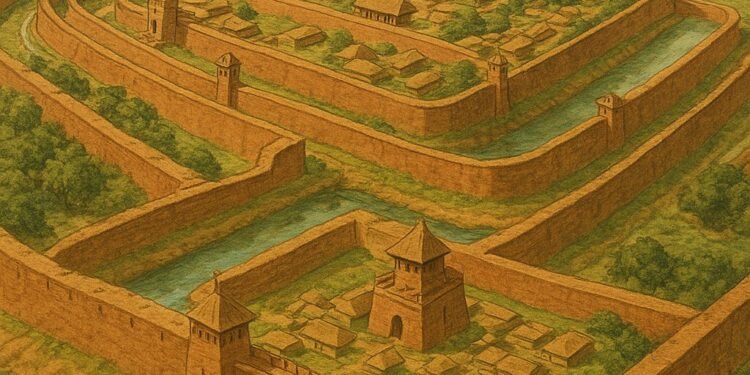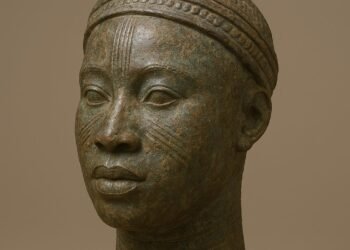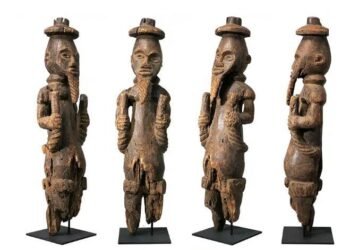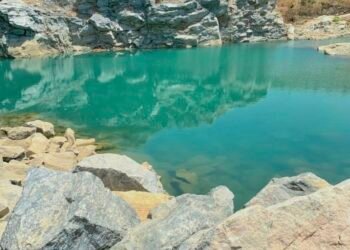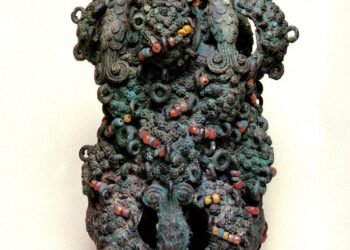The Great wall of Benin: Nigeria’s Forgotten Ancient Marvel
For ages, a secret was hidden in the dirt of southern Nigeria; a hidden gem of ambition and soil, not riches. The Great Walls of Benin, the Iya to the Edo, are among the most significant achievements of engineering in all of human history.
This complicated system of walls and moats was the awe-inspiring center of the Benin Kingdom, a people whose excellence was only matched by the size of their building appetite. Its history is a significant chapter in human history that needs to be appropriately remembered.
Table of Contents
Where is the Great Wall of Benin Located?
By the 11th century, Benin was an extremely well-run kingdom; not a loose collection of villages by any means. There was a clear hierarchy in the territory, efficient systems of trade, and sophisticated artistic culture, most notably making the great Benin Bronzes.
Politics centered around the Oba, who served as both the political leader and the religious leader, giving coordinated direction to state affairs as well as spiritual life. The kingdom’s organization and achievements placed it as a modern, strong polity in West Africa.
Read Also: Explore the Beauty and Culture of Igbara Oke
Under a succession of great Obas, the kingdom grew, and a defense system befitting its reputation had to be created. The walls rose in earnest, a task that would take generations.
The Great Wall of Benin – A Strategic Defense System
The word “walls” does not do justice to the masterful military tactics behind Benin’s earthworks. This was a defense system that seamlessly joined up.
Laborers dug deep trenches, pushing the new spoil right up beside them to form steep, impassable banks. It was a harsh double obstacle for an invader: first a wide, watery trench to wade through and then a greasy, sloping bank to fight up over.
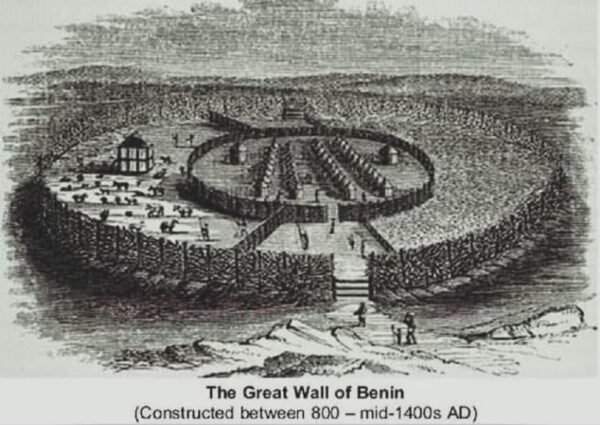
Still more impressive than encircling the capital, this ingenious network flowed through the land of the kingdom. It built an enormous, interconnected network of defenses, piecing together and defending a massive piece of territory with an imposing barrier of water and land.
The Great wall of Benin – A Scale Almost Unfathomable
The sheer magnitude of Benin’s construction project defies easy comprehension.
This was not a simple wall but an immense network of earthworks. Recent studies, combining satellite technology and physical surveys, confirm the system’s total length stretched over an astonishing 16,000 kilometers. Its length would easily wrap a significant portion of our globe.
This is the grandest single archeological feat on our earth and the world’s largest building project before the introduction of modern machinery. The volume of earth moved is a tangible testament to a titanic, century-long mobilization of human will and labor, an eye-stopping coordination of men and materials that reshaped the land itself.
Read Also: A Guide To The Amazing Facts About Idanre Hills
The Great wall of Benin – Precise Mathematical Planning
The brilliance of Benin’s architects shone not just in physical construction but in intellectual vision. Their city’s layout reveals a profound, intentional grasp of geometry that feels almost modern.
The design employed a fractal pattern, where the same elegant organizational principles repeated at every scale. The complex layout of the royal palace was not an isolated masterpiece; it was the blueprint.
This same pattern echoed in the organization of the entire city and down to the arrangement of individual family compounds. This was far from accidental.
It represented a conscious, sophisticated application of mathematical thinking to forge an urban environment that was both deeply efficient and inherently harmonious, a true marvel of precolonial planning.
The Great wall of Benin – The Walls as a Living System
While defense was their primary role, the walls were the central nervous system of the kingdom.
They were a visible physical symbol of the authority of the Oba, a tangible symbol of the state’s power that the people saw and dealt with every day. They were economically managed checkpoints, managing the flow of trade commodities like ivory, pepper, and palm oil. This control enabled the kingdom to regulate its wealth and tax commerce, fueling its prosperity and masterpieces.
The Great wall of Benin – Firsthand Accounts of Astonishment
European explorers who arrived at the Benin Kingdom were welcomed to a view that dissipated their prejudices. With the anticipation of encountering a primitive civilization, they instead encountered a city as big and advanced as their own capitals.
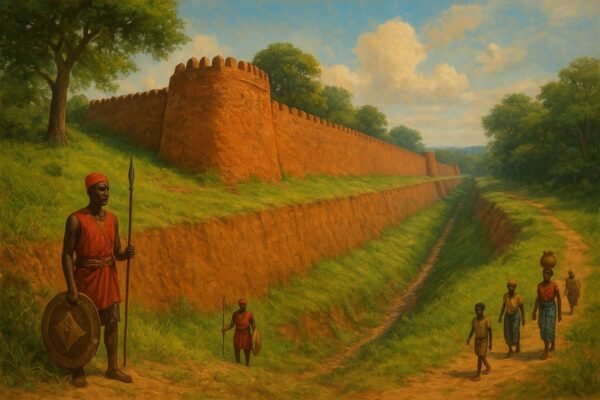
Portuguese and later Dutch traders documented their awe in detailed accounts. They wrote of an urban center larger than Lisbon, with wide, purposeful streets and a royal palace of breathtaking scope and organization.
The Dutch spectator Olfert Dapper provided a revealing fact: the palace walls were maintained so carefully that their surface was polished to a highly polished, mirror-like finish.
This diligent upkeep revealed a culture that was imbued with a highly developed sense of civic pride, leaving visitors completely abashed by what they were seeing.
The Great wall of Benin – What Happened to The Wall of Benin?
The glorious era of the Benin Kingdom ended abruptly and in blood in 1897. Under the pretext of punishing the British mission for having been attacked by an earlier delegation, a well-armed British force mounted a punitive expedition.
Read Also: Ogbunike Caves: A Hidden Natural Wonder in Anambra
What came next, though, was more than a battle; it was a campaign of destruction. British troops repeatedly shelled, fired, and razed Benin City to the ground.
The ancient walls themselves were not wanton destruction, but they were left in ruins, their mighty ramparts broken.
This was a symbolic act, one that aimed to annihilate the kingdom’s defenses in body and utterly wreck its morale, reducing a great civilization to crashing, smoking rubble.
The Great wall of Benin – Systematic Cultural Pillaging
A systematic campaign of cultural plundering supplemented the physical destruction of the city. While British troops were destroying Benin City, troops systematically looted the palace of the royal court, and they took thousands of irreplaceable items.
The finest examples were the magnificent bronze plaques and intricately carved ivories now celebrated as the Benin Bronzes. To the citizens of Edo, they were not lovely trinkets; they were historical documents, religious artifacts, and symbols of their identity.
This methodical plundering was a conscious attempt to rob the kingdom of its remembrance, its very existence, and its primitive identity, causing a wound that would resonate for generations. The discarding of these treasures was an act of cultural erasure.
The Great wall of Benin – Fragments of Memory
Few traces of the stunning earthworks remain. Fragments, thickly overgrown remnants of the ramparts, stay in the rural landscape of Benin City today. In Obasagbon village, there is a serene watchman in the shape of a house whose cornerstone has been seamlessly incorporated into what is left of the venerable red earth wall.
These delicate sites are becoming increasingly vulnerable, as they’re constantly under threat from urban expansion and natural wear. They represent a fragile but significant link to an incredible past.
To ensure they stick around, we really need urgent archaeological work and committed preservation efforts to keep this priceless connection to history alive for generations to come.

The Great wall of Benin – Wall of Benin Today
Not just simple artifacts of history, the Benin walls are a focal point in an international conversation about historical injustices and reparations. The push today to repatriate the Benin Bronzes (objects seized unwillingly in 1897) is immediately applicable to that heritage.
Read Also: Olumo Rock’s History: A Fascinating Journey Through Time
Classification of such objects as simply “artworks” is reductive. The bronzes have Benin’s identity, collective memory, and continuity within them. Restoration is not only the recovery of artifacts, but also the healing of culture and the redressing of inner social wounds.
Architecturally, the Benin walls and their attendant bronzes are irrefutable evidence of a cosmopolitan, self-contained civilization. The structures attest to elaborate urban design and defense engineering, decades earlier than the European interference. These aspects serve to testify to the innovative capability and organizational sophistication within the precolonial African societies.
At its essence, this issue goes beyond the mere reappearance of material culture. It is a shift to reclaim repressed heritage and restore an original narrative, preventing erasure, which came after colonial dominance. The implications are far from corporeal, yet they activate the reclaiming of cultural agency as much as historical integrity.
